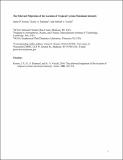The poleward migration of the location of tropical cyclone maximum intensity
Author(s)
Kossin, James P.; Vecchi, Gabriel A.; Emanuel, Kerry Andrew
Downloadkerry 4 KEV_manuscript_2014.pdf (4.049Mb)
PUBLISHER_POLICY
Publisher Policy
Article is made available in accordance with the publisher's policy and may be subject to US copyright law. Please refer to the publisher's site for terms of use.
Terms of use
Metadata
Show full item recordAbstract
Temporally inconsistent and potentially unreliable global historical data hinder the detection of trends in tropical cyclone activity. This limits our confidence in evaluating proposed linkages between observed trends in tropical cyclones and in the environment. Here we mitigate this difficulty by focusing on a metric that is comparatively insensitive to past data uncertainty, and identify a pronounced poleward migration in the average latitude at which tropical cyclones have achieved their lifetime-maximum intensity over the past 30 years. The poleward trends are evident in the global historical data in both the Northern and the Southern hemispheres, with rates of 53 and 62 kilometres per decade, respectively, and are statistically significant. When considered together, the trends in each hemisphere depict a global-average migration of tropical cyclone activity away from the tropics at a rate of about one degree of latitude per decade, which lies within the range of estimates of the observed expansion of the tropics over the same period. The global migration remains evident and statistically significant under a formal data homogenization procedure, and is unlikely to be a data artefact. The migration away from the tropics is apparently linked to marked changes in the mean meridional structure of environmental vertical wind shear and potential intensity, and can plausibly be linked to tropical expansion, which is thought to have anthropogenic contributions.
Date issued
2014-05Department
Massachusetts Institute of Technology. Department of Earth, Atmospheric, and Planetary Sciences; Massachusetts Institute of Technology. Program in Atmospheres, Oceans, and Climate; Woods Hole Oceanographic InstitutionJournal
Nature
Publisher
Nature Publishing Group
Citation
Kossin, James P., Kerry A. Emanuel, and Gabriel A. Vecchi. “The Poleward Migration of the Location of Tropical Cyclone Maximum Intensity.” Nature 509, no. 7500 (May 14, 2014): 349–352.
Version: Author's final manuscript
ISSN
0028-0836
1476-4687